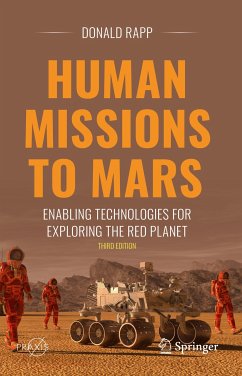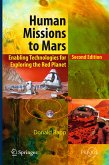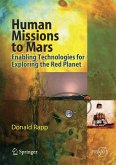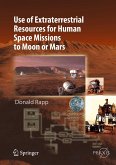Retained from the second edition, Donald Rapp looks at human missions to Mars from an engineering perspective. This includes analyzing the steps in the various proposed mission architectures, as well as the various vehicles and supporting technologies that are involved. In this connection, he discusses the status and potential of a wide range of technologies essential to a human mission to Mars, including life support, radiation, and low-gravity effects, getting there and back, in situ resource utilization, and mission safety.
Detailed appendices describe availability of solar energy on the Moon and Mars, as well as the distribution of near-surface H2O.
The third edition includes new information acquired from 2015 to 2022: · Significantly expanded discussion of Mars Ascent Vehicle · Discussion of the Moon-Mars connection · Review of a dozen additional Mars mission concepts · Expanded discussion of Ecological Life Support with emphasis on reliability issues · Expanded discussion of missions with nuclear propulsion · Extended review of new NASA Mars directions 2019-2022 · Expanded discussion of human factors and habitats · Expanded discussion of ISRU including results based on "MOXIE" on Mars · 33 new figures · 80 new references
Dieser Download kann aus rechtlichen Gründen nur mit Rechnungsadresse in A, B, BG, CY, CZ, D, DK, EW, E, FIN, F, GR, HR, H, IRL, I, LT, L, LR, M, NL, PL, P, R, S, SLO, SK ausgeliefert werden.
"A skeptic's view on the realities of sending a human mission to Mars in the 21st century. ... Human Missions to Mars is hardbound, and Rapp's use of supporting formula, graphs, and technical illustrations ... make it clear that this volume is meant to be used as a reference book in research institutions, technical libraries, and scientific organizations. However, Rapp's engaging writing style and pragmatic view on this subject also makes it an interesting read for the armchair Mars explorer ... ." (Anthony Young, The Space Review, March, 2008)
"This book looks at human missions to Mars from an engineering perspective. ... The book includes appendices describing the use of solar energy on the Moon and on Mars and the value of indigenous water on Mars. This book was written for space scientists and engineers, intermediate-level undergraduates, and postgraduate researchers studying every aspect of human missions to Mars." (The Lunar and Planetary Information Bulletin, 2008)
"Rapp's book is a very readable, critical view of possible explorations of Mars. ... The book discusses in detail the many technologies that must be developed and demonstrated before a successful human mission to Mars can occur. ... The appendixes give significant details about solar energy and water on Earth's moon and Mars. The work is an excellent analysis of the difficulties posed by a human mission to mars. ... Summing Up: Recommended. Upper-division undergraduate through professional collections." (D. B. Mason, CHOICE, Vol. 45 (9), 2008)
"In this book, Donald Rapp ... sets out to provide a critical assessment of the requirements for human missions to Mars from an engineering perspective. ... I found it informative because I learned a lot about the intricacies of Mars mission architectures and the inherent engineering challenges. ... it is refreshing to read a detailed and independent study by someone who has no vestedinterest in any 'official' plans for human space missions." (Ian Crawford, Eos, Vol. 89 (36), 2008)









